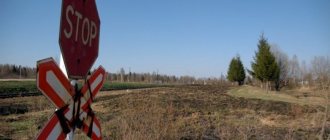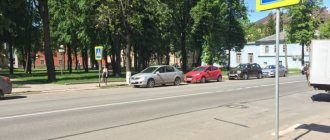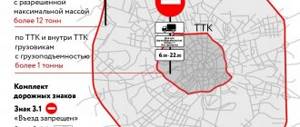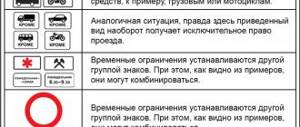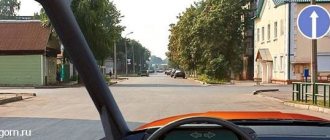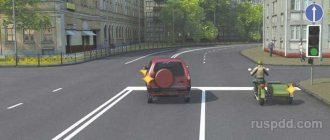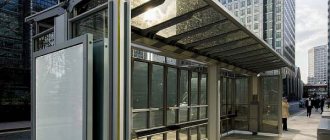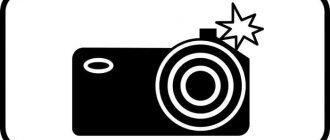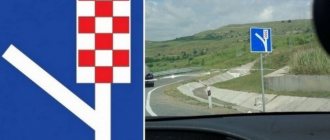Good afternoon, dear reader. In the current age of modern technology, when developing cities strive to cover the entire territory with video surveillance systems and create safer living conditions for ordinary citizens, there remains the other side of this event, this is the automatic recording of administrative offenses by structural divisions of the Russian Ministry of Internal Affairs.
Today I propose to thoroughly understand such notorious moments as passing a “stop line” or a “stop” road sign.
Picture of a “Stop” road sign (“Driving without stopping is prohibited”)
Why do we need a stop line and a stop sign?
Let's start with the understanding that “stop lines” and a “stop” road sign are vital for us, because pedestrians and other motorists need space to cross the road, and besides, visibility for such a maneuver is significantly reduced when a pedestrian looks out from behind a standing route taxi at the pedestrian crossing. There is a huge risk that a car is moving in the opposite direction.
Surely each of the readers has seen or knows stories where people suffered in a similar situation, they suffered significant harm to their health, experienced severe emotional shock, spent money on expensive medications, and often even died as a result of such accidents. In such a situation, it does not matter whether the pedestrian or the driver was right. An indirect role in this tragedy was played by the driver who passed the stop line and did not leave free space for other road users to see.
Therefore, even when you have crossed the stop line, do not continue driving; you should not take risks and create dangerous life situations for others.
And again, the “stop line”, when used correctly, plays a significant role in regulating traffic flows, namely in front of an intersection where every car is randomly jostling, the traffic jam indicator is much higher, in contrast to an intersection where drivers do not start moving and leave the intersection clear until there is free space for their direction of movement.
Penalty for violation
The punishment is a fine, the amount of which depends on the type of stop line and the section of the road where the violation occurred. The procedure for imposing a fine is regulated by Part 2 of Article No. 12.12 of the Code of Administrative Offenses of the Russian Federation:
- Driving onto the indicated road markings at a controlled intersection with a stop sign or stop line is punishable by a fine of 800 rubles.
- If the intersection is unregulated and the only limiting sign is the “STOP” sign, the fine is reduced to 500 rubles.
- Often, traffic police officers do not lose the opportunity to issue an additional fine for driving through a red light. Such a violation is punishable by an additional 1,000 rubles. according to Art. No. 12.13 Code of Administrative Offenses of the Russian Federation.
- If all the rules were followed, but the driver simply did not have time to cross the intersection due to a traffic jam, then there may be two options for the development of events, all of them are represented by fines. If the driver continues driving, the fine is 1,000 rubles. If the driver decides to back up, the fine is reduced to 500 rubles, but does not exclude his guilt, since driving back increases the likelihood of an accident.
If repeated violations of the same kind are registered within a year, the driver will not be deprived of his license, since the legislation does not provide for any measures to toughen punishment. Remember that only the fact that the wheels of a vehicle cross the stop line is considered a violation. If, after stopping, the markings are under the bumper, but the wheels did not drive over them, this is not a violation. Departures beyond the stop line can be recorded either by a traffic police officer or by special cameras installed everywhere.
In the first case, the fine is issued on the spot. In the case of a camera, the driver receives a notification of a fine issued by mail.
A few numbers about the location of markings and signs
Now a few words about fulfilling the requirement to stop at the Stop Line. Marking 1.12 or sign 6.16 “Stop line” is a place (line) on the roadway in front of which the driver must stop when further movement is prohibited (at a prohibiting traffic light signal or a traffic controller’s gesture and at the request of sign 2.5 “Driving without stopping is prohibited”
Legal consultation
Get qualified help right now! Our lawyers will advise you on any issues out of turn!
To get a consultation
Thus, when there is a 1.12 marking on the roadway or there is a 6.16 sign, you need to stop in front of the stop line (before the 6.16 sign). More precisely, according to traffic rules, you need to stop at a stop sign not on the line, but in front of the line. Photo and video recording cameras should record the crossing of the stop line not by the front wheels, but by the front bumper of the car, i.e. its protruding part. Crossing (driving) the stop line, or going beyond the stop line at a prohibiting signal entails sanctions under Article 12.12. Part 2 of the Administrative Code.
If a stop sign is installed without a stop line marking, then it is placed at the distances specified in GOST for this marking:
- 10 - 20m from traffic lights when they are located above the roadway,
- and 3 - 5 m from traffic lights when they are located on the side of the roadway.
The numbers are given so that you can imagine the dimensions of the intersection of the roadways of the intersection.
In clause 6.16 of the Traffic Regulations of the Russian Federation it is established that it indicates the place where vehicles stop when there is a prohibitory signal from a traffic light (traffic controller). The driver is required to stop in front of the stop line or the sign itself, if there is none.
Often, due to difficult climatic conditions, poor-quality materials and non-compliance with technology, the applied stop line markings become poorly visible or become completely unusable.
It is important to remember that the traffic rules state:
- A temporary sign is more important than all elements of road construction.
- If a sign contradicts the markings, including temporary ones, or when they are not sufficiently distinguishable, then the sign is more important.
- In cases where permanent marking lines and temporary marking lines contradict each other, drivers must be guided by the meaning of the temporary markings.
- Temporary markings take precedence over permanent markings.
Thus, it became clear to you and me that in cases where the markings are located before the stop sign, there is no violation and the imposed offense can be appealed.
Intersection rules
Incorrect crossing of the stop line occurs in two cases: either the driver is not familiar with the traffic rules, or the traffic within the city is too intense and difficult. In fact, the algorithm of actions on the part of the driver is extremely simple: the movement must be stopped immediately as soon as the stop line is under the hood of the car.
If the driver does not have a good sense of the dimensions of his own car, he must stop as soon as the markings disappear from view. This method is universal among beginners.
If the driver stops correctly, the view of the traffic light located above the road will be completely open - this is what the markings are designed for. In order not to receive a fine for crossing the stop line, it is worth analyzing all the conditions for placing the markings in question:
- If a stop line is placed at a controlled pedestrian crossing, it is necessary to stop only when this is indicated by the actions of the traffic controller or a red traffic light. In other cases, you can freely cross the line.
- At a controlled intersection the situation is similar.
- If the intersection is unregulated, there must be a “STOP” sign; therefore, the driver stops and makes sure that his vehicle does not interfere with other road users.
- If we are talking about a controlled railway intersection, the procedure is similar to the first point.
- Driving through an unregulated railway intersection is regulated by the same rules as point 3.
This is interesting: 9 main fines for illegal parking in 2018 and advice from a car lawyer on how to avoid them
Rules for driving under the stop control sign
Sign 3.17.3 - Control
It is worth noting that it is necessary to distinguish the stop sign from the control stop sign, which is enshrined in clause 3.17.3 of the Russian Traffic Regulations, which states that it prohibits driving through checkpoints without stopping. The sign is also installed on toll roads in front of the toll booth; in this case it is used with a sign.
This sign is quite rare, for example near:
- Traffic police posts;
- border zones;
- quarantine posts;
- entrances to closed areas.
However, the actions of the driver are not very different from the actions when there is a sign “driving without stopping is prohibited”: the sign “driving without stopping is prohibited” means that you need to stop in front of the sign, but you can continue to follow your route only after all the steps have been completed. procedures provided for by law and the Traffic Rules (checking documents, inspecting or inspecting vehicles, etc.), and naturally, after the appropriate permission from the checkpoint officer.
Important!
You should not treat this sign carelessly, because... if there are legal grounds for the presence of this sign, the security forces even have the authority to open fire on your car, but most likely they are conducting a special operation or guarding a sensitive facility and by your actions you are formally committing another administrative offense - disobedience to the legal request of a government official, so remember that the sign requires a mandatory stop.
What does the sign look like?
Dear readers! The article talks about typical ways to resolve legal issues, but each case is individual. If you want to find out how to solve your particular problem , contact a consultant:
+7 (Saint Petersburg)
APPLICATIONS AND CALLS ARE ACCEPTED 24/7 and 7 days a week.
It's fast and FREE !
Road sign 2.5 “Driving without stopping is prohibited” is known to both pedestrians and drivers. In most countries of the world, it is depicted in the same way: four white Latin letters are written on a red octagon: “STOP”. The edging of the figure is also done in the form of a white stripe.
A special geometric shape is necessary so that the sign can be recognized even if it is dirty, damaged by vandals, or covered with frost or snow.
According to the recommendation of the Vienna Convention of 1968, other variations of the image can be used: a red circle with a triangle located inside with a yellow or white background in the middle.
Black and blue letters are allowed. The UN Convention explains that the word “stop” does not have to be written in Latin: each state has the right to approve a sign made using its official alphabet.
In our country, only the first variety is used. In addition to it, the traffic rules provide information plate 6.16, which is used in conjunction with marking 1.12 “Stop line” or instead of it, marking the border on the roadway before the intersection.
These graphics serve a slightly different function: they inform the driver where in front of a traffic light he needs to stop to wait for the green signal.
Daily meetings with auto-fixation cameras
The main thing to understand here is that the auto-fixing camera is a weak-willed machine, into which several coordinates have been driven in, creating a straight line, beyond which you cannot drive when the traffic light turns on, and a simple algorithm for performing this action has been established. Regardless of the situation on the road, she will perform the task assigned to her.
You can go to the traffic light, but stay behind the stop line and not get to the intersection due to a traffic jam. And as soon as the prohibitory traffic light comes on, the camera has faithfully recorded your offense.
You can start driving on a yellow (prohibiting) traffic light, but you will still receive an administrative fine.
There are also cases when, due to repair work, the traffic light is turned off, but the auto-fixation camera does its job properly here too.
Often in life there are cases when a stop sign is installed on a four-lane road under a traffic light. From the fourth lane it is practically invisible due to the car standing next to it. It is quite unsafe to drive in the fourth lane and look to the far right lane for a stop sign.
In accordance with GOST, the stop sign is installed to the right of the road or above the roadway. It is permissible to install a sign above each traffic lane, i.e. GOST specifies the location of the sign to ensure its better visibility. Why they don’t do it is a complicated question. You must write a statement to the traffic police department
It should also be said that when a three-color traffic light is switched to a yellow flashing signal, the section of the road that this traffic light regulates becomes unregulated. In this case, there is no need to stop at the stop line.
If it is necessary to give way (for example, at an uncontrolled intersection or an unregulated pedestrian crossing), it is enough to stop the car on the roadway in such a way that priority is respected.
In any case, carefully monitor the traffic situation and make timely decisions to appeal administrative offenses received through auto-recording cameras.
Controversial situations and filing an appeal
Controversial situations most often arise when a violation is recorded by a camera. Among the most common controversial situations, it is worth highlighting the moment when the markings are crossed by the bumper, but not by the wheels. It also happens that there is a large shadow in the photo that can be mistaken for car wheels. The driver has every right to file an appeal, and the procedure itself is implemented in the following order:
- Collection of evidence, which may include witness statements or photographs from a camera. Try to collect as many facts as possible in your favor.
- File an appeal in your local civil court within 10 days of receiving the penalty notice in the mail.
In addition to the controversial situations discussed at the beginning, cases may be as follows:
- If the driver drove beyond the stop line at a yellow light, penalties will also follow. The yellow signal does not allow movement and belongs to the prohibiting category.
- Hitting a marking and reversing. In fact, a violation took place, but it will only be registered if an oversight on the part of the driver was recorded by a camera or a traffic police officer.
- There is no uniform standard regarding the distance from the marking to the regulated section of the road. The distance itself varies within 0.5 - 1.5 m, therefore, the driver himself may not notice how he crosses the line if it has become erased over time. In such a situation, a fine will still be issued, but the driver has every chance to challenge it in court. It is enough to simply prepare detailed photographs of the questionable section of the road.
This is interesting: Do-it-yourself Chevrolet Cruze seat removal
Driving schoolhome traffic rules online
We have launched free distance learning on Youtube. Subscribe to our channel and watch video lectures.
Road markings are one of the most important means of visual orientation for drivers. It is not surprising that there are questions about marking in every exam paper (35 problems about horizontal markings and 5 problems about vertical markings). The ticket compilers tried to cover, if not all the markings, then at least the most important of them.
Longitudinal solid
white lines.
First of all, traffic organizers needed to separate traffic flows in oncoming directions, as well as mark the boundaries of the roadway.
These problems are solved using solid longitudinal lines
road markings.
Problem 1
| Are you allowed to cross a double solid longitudinal line? 1. Permitted only when leaving the yard and other adjacent areas. 2. Allowed only when overtaking. 3. Allowed only in heavy traffic. 4. Not allowed. Comment on the task A double continuous longitudinal marking line separates oncoming traffic flows. Crossing it is strictly prohibited; doing so can result in the loss of your license. |
Problem 2
| In which of the indicated places are you allowed to cross the solid marking line and stop? 1. A and B. 2. Only B. 3. In the indicated places it is prohibited to cross the solid marking line. Comment on the task Solid lines 1.2 show the boundaries of the roadway. To the right of line 1.2 is the shoulder, to the left is the dividing strip. This is what the Rules say about this line: “Line 1.2 may be crossed to stop a vehicle on the side of the road.” And stopping traffic on the dividing strip is strictly prohibited. This is understandable without any Rules. |
Problem 3
| Is it allowed to cross a solid marking line marking the edge of the roadway? 1. Allowed when stopping on the side of the road and when leaving it. 2. It is allowed when stopping on the side of the road and when leaving it only in places where stopping or parking is permitted. 3. Prohibited. Comment on the task It is clear that the most correct answer is the second answer. If there is a shoulder, stopping is only allowed on the side of the road. And here you can safely cross the solid line separating the roadway from the side of the road - the rules do not object (unless, of course, there are signs or markings prohibiting stopping on this section of the road). |
Longitudinal intermittent
white lines.
Broken lines are very diverse; with their help, many different problems are solved on the roads. And they ask about all this during the exam.
Problem 4
| What maneuver are you prohibited from performing with this marking line? 1. Overtaking. 2. Detour. 3. U-turn. 4. All of the above maneuvers are permitted. Comment on the task The Rules do not say anywhere that driving into oncoming traffic is allowed on two-lane roads. But nowhere does it say that this is prohibited. And what is not prohibited is permitted! And if the center line is broken, you can safely overtake, go around and turn around - the rules do not prohibit. |
Problem 5
| Is it possible for you to overtake if there are these markings? 1. Can. 2. It is possible if the tractor speed is less than 30 km/h. 3. It is forbidden. Comment on the task On this section of the road, the center line is combined, consisting of both a solid and a broken line. The Rules assigned the number 1.11 to such markings and allowed it to be crossed from the intermittent side ( as well as from the continuous side, but only upon completion of overtaking or detour! ). So on this section of the road you can safely overtake not only this tractor, but any vehicles in general. |
Problem 6
| Is it possible for you to overtake if there are these markings? 1. Can. 2. It is possible if the tractor speed is less than 30 km/h. 3. It is forbidden. Comment on the task And again the combined centerline is 1.11. Only now on our side there is solid and that means no overtaking! And, by the way, turning around is also prohibited! And even for avoiding an obstacle while driving into oncoming traffic, you can get a fine of 1000-1500 rubles. |
Problem 7
| Movement is permitted: 1. Only along trajectory A. 2. Only along trajectory B. 3. Along any trajectory from those indicated. Comment on the task And again the combined marking line 1.11 (in this case on a short section of the road). And you already know that such markings are allowed to be crossed only from the intermittent side. More precisely, it is allowed to cross it from the side of the solid road ( but only upon completion of overtaking or detour! ). In all other cases, crossing the combined line 1.11 from the solid side is prohibited! |
Problem 8
| What does an increase in the stroke length of the dashed marking line inform you about: 1. About the beginning of the zone where any maneuvers are prohibited. 2. About the beginning of a dangerous section of the road. 3. About approaching a solid marking line dividing traffic flows in the same direction. Comment on the task Notice how the length of the dashes of the broken line dividing the roadway into traffic lanes has noticeably increased - this is the so-called “approach line”, informing drivers that the broken line will soon become solid. And if the driver needs to change lanes, now is the last opportunity. |
Problem 9
| What do the broken lines at an intersection mean? 1. Mandatory direction of movement at the intersection. 2. Traffic lanes within the intersection. Comment on the task In the vast majority of cases, you will not see any markings at the intersection. At intersections, the marking lines are broken (otherwise no movement through the intersection will be possible). But sometimes markings are also applied at intersections, although not just any kind, but special ones. At this intersection, markings allow left turns from two lanes. At the same time, the markings also tell drivers the boundaries of the lanes within the intersection when turning left so that when turning left, drivers do not get lost and end up in oncoming traffic or collide with each other. (Note in parentheses that this marking has short strokes and equal intervals). |
Problem 10
| Are you allowed to change lanes with reversible traffic in this situation? 1. Allowed. 2. Permitted only for left turns or U-turns. 3. Prohibited. Comment on the task On the middle lane of this road, reverse traffic is organized. The boundaries of the reversible lane are marked with special markings 1.9 (double broken lines with long strokes and short gaps), and reversible traffic lights are hung above the lane itself at a visibility distance from each other. You can only occupy this lane if the green arrow is on at the reversing traffic light. And in the situation shown, it is the green arrow that is turned on for us. So you can safely change lanes into the reverse lane. |
Problem 11
| Are you allowed to enter a lane with reversible traffic if the reversible traffic light is turned off? 1. Allowed. 2. Allowed if the bus speed is less than 30 km/h. 3. Prohibited. Comment on the task On such a road, when the reverse traffic lights are turned off, it is strictly prohibited to enter the middle lane! And it is prohibited for everyone: both us and drivers of oncoming vehicles! |
Problem 12
| Are you allowed to perform such a maneuver when the reversing traffic lights are turned off? 1. Allowed. 2. Allowed if there are no oncoming vehicles. 3. Allowed for overtaking only. 4. Prohibited. Comment on the task On a road with an even number of lanes, the 1.9 marking can be placed in the middle of the roadway, and this marking alone informs drivers that reverse traffic is organized in this area. But there are two reversible traffic lights! And they are located to the right and left of the axial markings 1.9. And that means this road has two reversible lanes! Now let's see what's on at the reverse traffic lights. And nothing lights up at reverse traffic lights. Indeed, how to behave on such a road if the reversible traffic lights are turned off for some reason. The rules clearly regulated this situation. Rules. as if a double intermittent line became a double solid line and it is forbidden to cross it (as on a regular multi-lane road without reverse traffic). |
Problem 13
| Are you allowed to change lanes? 1. Only allowed into the adjacent lane. 2. Permitted if the speed of the truck is less than 30 km/h. 3. Prohibited. Comment on the task Let us repeat once again - if reversing traffic lights are disabled, drivers should behave as if a double intermittent traffic light had become a double continuous one. That is, now there are two lanes in your direction, you can change to the left lane. |
Problem 14
| If the reversing traffic lights are turned off, you should: 1. Immediately change lanes to the right. 2. You can continue driving along the lane only until the intersection. 3. If there are no oncoming vehicles, continue driving along the lane. Comment on the task Another unclear moment. At the previous reversible traffic light, the green arrow was on, and you were moving along the reversible lane on completely legal grounds. And suddenly at the next traffic light nothing is on. What to do? Let's look at the Rules: Rules. |
Transverse marking lines.
The following types of markings can be applied across the roadway: pedestrian crossing, intersection with a bicycle path, speed bump, stop line, and marking 1.13 (white triangles in one line).
You can cross all cross markings, but you need to know what they inform you about.
Problem 15
| Which pedestrian crossing does this marking indicate? 1. Adjustable only. 2. Unregulated only. 3. Any. Comment on the task This is the familiar “zebra”. It is used to designate pedestrian crossings, and it doesn’t matter which ones - regulated, unregulated. And the yellow color was added here to further attract the attention of drivers - this is a place of increased danger! |
Problem 16
| This markup means: 1. The place where the residential area begins (ends). 2. Artificial hump on the roadway. 3. The place where the restricted parking zone begins (ends). Comment on the task We are talking about these “chess” on the roadway. The Rules came up with this marking to designate a “speed bump” - an artificial bump on the roadway. |
Problem 17
| In this situation you: 1. Must stop at the sign. 2. Must stop at the stop line. 3. If there are no other vehicles, you can drive through the intersection without stopping. Comment on the task The sign requires: “No stopping without stopping”! But where to stop? So there is a “stop line” across the roadway. It is precisely applied to show where you should stop. |
Problem 18
| You intend to turn left. Where should you stop to give way to a car? 1. In front of the sign. 2. Before the intersection at the marking line. 3. At the intersection in front of the broken marking line. 4. Any place at the driver's discretion. Comment on the task The correct answer is the second : “Before the intersection at the marking line.” We are talking about white triangles lined up in a row in front of an intersection. |
Inscriptions and symbols on the roadway.
Problem 19
| What does the marking in the form of the inscription “STOP” on the roadway mean? 1. Warns when approaching a stop line before a controlled intersection. 2. Warns of approaching a stop line and a “No driving without stopping” sign. 3. Warns of approaching a “Give way” sign. Comment on the task "STOP" marking is applied to each lane in this direction in order to additionally inform drivers about approaching In a populated area, the distance from the “STOP” sign to the stop line can be from two to ten meters, outside a populated area – from 10 to 25 meters. |
Problem 20
| Triangle lane markings: 1. Indicates a dangerous section of the road. 2. Warns you when approaching a place where you need to give way. 3. Indicates the place where you need to stop. Comment on the task a sign 2.4 “Give way” is installed in front of the intersection , then drivers will be informed about approaching it If you cannot give way without stopping, you need to stop at marking 1.13 (white triangles lined up in a row). |
Problem 21
| Markings in the form of the letter “A” indicate: 1. A special lane for all buses. 2. A special lane for route vehicles. 3. Stopping and parking place for any buses. Comment on the task Everyone knows this. Marking 1.23 (letter “A” on the roadway) indicate a lane intended for the movement of route vehicles. |
Problem 22
| The right lane is intended for traffic: 1. Any buses. 2. All buses and trolleybuses. 3. Buses and trolleybuses moving along established routes with designated stopping places, as well as school buses and passenger taxis. Comment on the task Strictly according to the letter of the Rules, this is a lane for route vehicles. But the same Rules also allowed school buses and taxi drivers to travel on it. |
Problem 23
| What does the A100 marking on the road mean? 1. Distance to the nearest intersection. 2. Distance to the nearest populated area. 3. Road or route number. Comment on the task Each road has its own number and its own prefix (the letter before the number). For example, the M-10 connects Moscow with the cities of Tver, Veliky Novgorod, St. Petersburg, Vyborg and further up to the border with Finland. |
Problem 24
| What do these lane markings mean? 1. Road or route number. 2. Recommended speed for this section of the road. 3. The permitted maximum speed on a given section of the road. Comment on the task Marking 1.24.2 duplicates the effect of prohibitory sign 1.24 “Maximum speed limit”. Please note that if the road is multi-lane, symbols will be placed on each lane. |
Problem 25
| Driving on the roadway lane designated for cyclists, which is marked with this marking, is permitted: 1. Only for mopeds. 2. Only for motorcycles with an internal combustion engine displacement not exceeding 125 cm3 and a maximum power not exceeding 11 kW. 3. All listed vehicles. Comment on the task Rules. But not in any lane at all, as cars and motorcycles are allowed. But only on the right edge of the roadway! And if there is a lane for cyclists at the edge of the roadway, you can use this lane (together with cyclists). And there is no place for any motorcycles here. This lane is for bicycles and mopeds only. |
Arrows on the roadway.
You will often see arrows on the roadways. Placed before intersections, they show permitted directions of movement, and outside intersections they inform drivers that their lane is ending. However, now you will see everything for yourself.
Problem 26
| If you have this marking on the traffic lane, you are allowed to: 1. Only turn left. 2. Just a reversal. 3. Turn left and turn around. Comment on the task Marking 1.18 (lane arrows) is placed on the roadway when approaching an intersection to show drivers the permitted direction of travel from each lane. At the same time, the markings that permit a left turn also permit a U-turn. BUT! At any intersection, turning around is only allowed from the leftmost lane! And you are just in the left lane, which means you can turn left and turn around. |
Problem 27
| These markings on the traffic lane: 1. Gives you priority when changing lanes to the right. 2. Informs you that the road turns right. 3. Warns you when approaching a narrowing roadway. Comment on the task In addition to the “hard” rectangular arrows showing the permitted directions of movement at intersections, the Rules also provide for “soft”, smoothly curved arrows, which are also intended for visual orientation of drivers. Markings in the form of smoothly curved arrows are used in cases where it is necessary to oblige drivers to change lanes from their lane to the adjacent lane. In this problem, you are essentially asked: “What awaits the driver around the corner?” And around the bend the driver faces a narrowing of the roadway. designed to move in a given direction. |
Three yellow markings.
In addition to white markings, the Rules also provide three yellow markings. All of them, in one way or another, are related to stopping and parking of vehicles, and they were made yellow so that they are visually easier to identify by drivers.
Problem 28
| Are you allowed to stop at this place? 1. Allowed. 2. Allowed without entering the sidewalk. 3. Prohibited. Comment on the task A solid yellow line (marking 1.4), drawn along the edge of the roadway or along the top of the curb, prohibits stopping vehicles and at the same time shows the coverage area of this restriction. That is, stopping is prohibited along the entire length of this yellow line! |
Problem 29
| Are you allowed to stop at this place? 1. Allowed. 2. Allowed only with entry onto the sidewalk. 3. It is allowed if it does not interfere with route vehicles. 4. Prohibited. Comment on the task In cases where it is necessary to introduce a ban on non- stop , but only for That is, parking is prohibited along the entire length of this yellow broken line. But stopping is not prohibited! |
Problem 30
| Are you allowed to park your car in this place? 1. Allowed. 2. Allowed only with partial entry onto the sidewalk. 3. Prohibited. Comment on the task You can stop along the entire length of this yellow broken line drawn along the edge of the roadway, but parking is prohibited. |
Problem 31
| This markup means: 1. A section of road where driving near the sidewalk is prohibited. 2. Places where any stopping is prohibited. 3. Bus stops and taxi ranks. Comment on the task Another yellow marking – Marking 1.17 – a zigzag line marked on the edge of the roadway (drivers call it among themselves a “ These markings indicate stops for route vehicles and taxi ranks. |
Problem 32
| Can you stop at this location to pick up or drop off passengers? 1. Can. 2. It is possible, if this does not interfere with the movement of route vehicles. 3. It is forbidden. Comment on the task The Rules allow other drivers to stop at designated stops for route vehicles. BUT! Only for one single purpose - for boarding and disembarking passengers. And only on the condition that this does not interfere with the movement of route vehicles. |
What to do if different markups contradict each other.
Or the requirements of the signs contradict the requirements of the markings.
Problem 33
| What should you do if the white and orange marking lines on the roadway contradict each other? 1. White marking lines. 2. Orange marking lines. 3. The rules do not regulate this situation. Comment on the task When road repairs are being carried out, But as long as there are orange markings on the roadway, drivers must adhere to its instructions! |
Problem 34
| What should you follow if the meanings of road signs and horizontal marking lines contradict each other? 1. Requirements for marking lines. 2. Requirements of road signs. 3. The rules do not regulate this situation. Comment on the task If the requirements of road marking lines contradict the requirements of road signs, drivers are required to comply with the requirements of the signs! For example, on this section of the road (up to the next intersection), despite the broken center line markings, overtaking is prohibited! |
Problem 35
| You can go around an obstacle: 1. Only along trajectory A. 2. Only along trajectory B. 3. Along any trajectory from those indicated. Comment on the task If the sign and markings contradict each other, drivers are required to comply with the requirement of the sign. In such a situation, you can safely go around the obstacle through a solid line - the Rules do not mind. |
What does a STOP sign look like?
The red sign is a scarlet octagon with white letters “STOP” on it. The edge of the figure is enclosed in a white border. Inscriptions made in black and blue paint are allowed, and the surface color of a temporary sign may be yellow.
In all countries of the world the sign is 2.5. has a predominant red color
The first STOP sign appeared in the American city of Detroit (Michigan) in 1915.
The white sign has a rectangular shape, the inscription “STOP” on it is black. There is a black border along the edge. This plate is not a priority and belongs to the category of information signs.
Plate 6.16 can even be installed above each specific lane
In the USSR, the “STOP” sign first appeared in 1973 in accordance with GOST 10807–71, which came into force, and became the 106th road symbol in the Traffic Rules.
Red STOP sign
This symbol is a priority and is installed in accordance with GOST R 52289–2004 to regulate the movement of vehicles at complex intersections in populated areas and on highways between cities.
What does it mean
The sign states that driving on this section of the road without stopping is prohibited.
Traffic Laws
According to traffic regulations, a red sign is installed near unregulated intersections, i.e. those without traffic lights. These are places where main and secondary roads intersect, T-shaped intersections, areas where visibility is limited for the driver. Usually the “STOP” sign is accompanied by a special marking - a stop line. Drivers must comply with the following rules:
- stop before the stop line. Hitting her is prohibited. If there are no markings, you need to stop at least 5 m before the intersection of transport arteries;
- Having stopped in front of a road symbol, it is necessary to provide passage for other cars on the intersecting (side) or main road and only then continue driving;
- When crossing a railway crossing, if there is no traffic light, a complete stop of the car is required. It is only prohibited to stop driving, even if there are no other road users within the viewing radius.
To indicate approaching the stop line 1.12, used in conjunction with 2.15 Driving without stopping is prohibited, markings 1.21 can be placed on the traffic lane - the word “Stop”
Where do you need to stop according to the rules?
In most cases, the “STOP” sign is placed together with markings 1.12 on the roadway. In this case, the driver of the car is obliged to stop in front of the line.
If it is missing, then it is necessary to stop driving before reaching the edge of the roadway that you plan to cross, giving way to all vehicles moving along it.
When crossing rails or approaching a quarantine post, you must also stop in front of the marked markings (stop line). If it is not marked, the vehicle must stop moving in front of the sign.
Important! Do not allow the car bumper to be above the markings. Many people believe that if the wheels have not reached the border marked by it, then there is no violation in this.
The recording camera will certainly react to such an action, and the driver will receive a decision to impose penalties.
White STOP sign
It is installed to inform drivers about the place where they need to stop if further movement is prohibited by a traffic light.
What does it mean
The main purpose is to warn drivers that there is a “Stop Line” marking ahead, where they need to stop if necessary.
The prohibition on movement under sign 6.16 is valid until it is permitted (for example, until the traffic light turns on).
Traffic Laws
According to traffic rules, the sign can be located on the right side of the road or hang above the part where the stop line is located. The driver must comply with the following rules:
- when the markings are not visible, you need to stop at the sign;
- when the traffic light permitting signal is on, you don’t have to stop on a difficult section;
- It is prohibited to drive into a stop line; this is a violation of traffic rules, for which you can receive a penalty.
